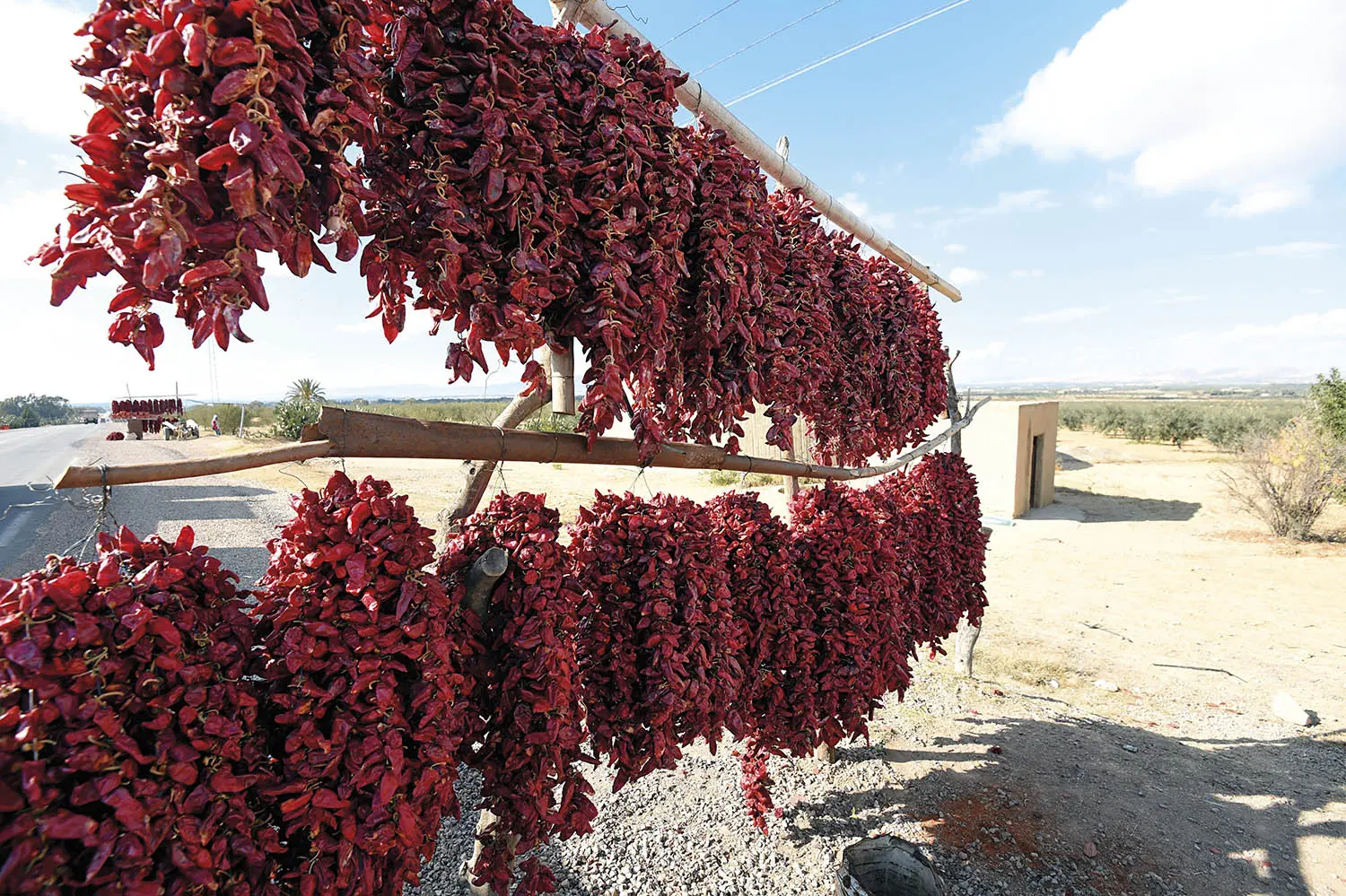The Spice of Life
Harissa won UNESCO recognition in 2022, not only for its ubiquitous role in Tunisian cuisine, but for the role it plays in Tunisian life.
By Catherine Mazy
Garlands of chili peppers festoon Tunisia. Brilliant crimson at harvest in late summer, they deepen in colour to garnet and deepen in flavour, too, as they dry in the sun. The garlands hang on houses, from souk stalls, in kitchens. They dangle from lines stretched across courtyards and fields, forming spiky red curtains. Their destiny: harissa, the hot, spicy paste that flavours dishes across North Africa, but that traces its roots to Tunisia.
“Harissa is our life. We add harissa to almost everything—pasta, shakshuka, couscous, tajine…You won’t find a home in Tunisia without traditional harissa,” says Malek Labidi, a Tunisian chef who is writing a four-volume encyclopaedia on Tunisian cuisine.
It goes in soups and sandwiches, on grilled meats, or to lift the flavour in sautéed vegetables like potatoes, says Kabira Bririch, founder of Mida, an artisanal producer of harissa and other food products.
“If you go to a restaurant, they’ll serve harissa with olive oil. You eat it with a little bread, to open the appetite,” says Sadri Smoali, chef at Dar Slah, a restaurant in the medina of Tunis. “We are born with it. As soon as a Tunisian opens his eyes, he sees it.”
In December 2022, UNESCO added harissa to its list of intangible cultural heritage of humanity, not just for the condiment itself, but for the role it plays in Tunisian life. Harissa is a staple of el oula. More than a pantry, el oula is a communal ritual of harvesting and preparing food for the rest of the year.

Ojja, eggs cooked in a spicy tomato sauce, including harissa, is a staple dish in Tunisia. It is sometimes called shakshuka, though it is not quite the same. The United Nations Industrial Development Organization’s PAMPAT project, backed by Swiss funding, has supported Tunisian harissa since 2013, aiding the country’s Ministry of Cultural Affairs in their bid to secure a UNESCO listing.
“El oula is certain products that you make yourself or that you buy directly from an artisan. They’re not industrial,” Labidi says. “You have couscous and all its relatives, because we don’t just have the usual grain but also the medium and large grains; harissa, of course; there’s olive oil that we buy by the jerrycan directly from the farmer; there are capers, olives, and little chilis in brine—all that is part of el oula.”
At the end of summer, women gather to make el oula, stocking them in beit el mouna—a dark, dry room found especially in the countryside where homes have more space. The work is communal and takes months—from the back-breaking work of planting peppers to the back-breaking work of harvesting them, then impaling the chilis on long skewers or lacing them together with string. And then the labour-intensive assemblage of the harissa. Tunisians who don’t have time, space or inclination to do all the work themselves must turn to a seller at the market or to a trusted supplier—Labidi gets her harissa from an aunt. “She’s blind, but she makes extraordinary harissa for the whole family.”

Bririch works with an association for rural women who make harissa to supplement their families’ income. To improve the women’s opportunities to commercialise their products, as well as to stay within the norms and laws of Tunisia, in 2019 she created a company, Mida, which means table. The result is prize-winning harissa and other oula staples, including orange flower water, olive oil and bsissa, a kind of sweet spread made from grains, seeds, dried fruits and spices, all toasted and ground to a paste. “Our secret is the savoir-faire of our ancestors, our mothers and our grandmothers,” she says.
There are three kinds of harissa: cooked, smoked, and traditional. Most industrial harissa—what you’ll find exported outside Tunisia—is cooked by steaming fresh chilis, so it must be made at harvest time. “What we export, it’s cooked and is like a paste,” Smoali says. In Tunisia, “we like it ground so you see the morsels. It’s still a paste, but it’s drier.”
The harissa based on dried chilis can be made all year. The garlands can be smoked over a fire of olive wood or bitter orange tree wood. But for traditional harissa, the chilies are simply sun-dried, whether hung in garlands or spread on sheets on the ground.

After washing and removing the seeds and peduncle, the chilis are ground—with a meat grinder or a mortar and pestle—with garlic, ground coriander, ground caraway, salt and olive oil. “No preservatives. No colour additives. All natural,” Bririch says.
The word harissa comes from the Arabic word harasa, or to crush, pound or grind. But the main ingredient, chili peppers, came from the New World after 1492, along with tomatoes, potatoes and chocolate, brought to Europe by Spanish explorers and spread across the Maghreb by Moors.
Several varieties of chilies can be used for harissa—beldi, maamouri, meski, baklouti, mserreh—“each region uses what they have,” Smoali says. For example, the name baklouti comes from the city of Bekalta and maamouri from Maamoura. Tunisia counts five main pepper-growing regions: Cap Bon, Sahel, Sidi Bouzid, Kairouan and Oasis de Gabes.
Cap Bon is home to Nabeul, which has hosted a harissa festival for the past nine years, featuring tastings, cooking demonstrations and prizes for the best harissa. Harissa is a big tent condiment, with regional and even familial tweaks to the basic recipe. The harissa of Nabeul is very simple, whereas that of Djerba uses many more spices, including cumin, or dried herbs like thyme or rosemary, Smoali says. Modern takes include dried mint or ginger, Labidi notes.
Another preparation, harisset mayou, is made for the much-anticipated ojja mayou, or May omelette, that residents of Nabeul eat to celebrate the beginning of the agricultural season. It’s a mix that’s about half ground, dried chili peppers, and half dried herbs such as marjolan, thyme, basil, mint, rosemary, young cactus leaves, leaves of orange, apricot and sweet lemon trees, and juniper berries.
Some of the ingredients have medicinal properties, Bririch says, and “May is the month when you find all the plants in the forest.” The spicy omelette is a quick yet hearty lunch for men working long days in the fields. “In Tunisia, people are very connected to nature,” Labidi says. “They eat what’s in season and eat the good things at the right time.”
Photographs from top: Fethi Belaid / AFP via Getty Images; OURTUNISIANTABLE.COM; COURTESY OF UNIDO; Quanthem / iStockPhoto




